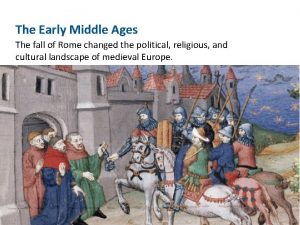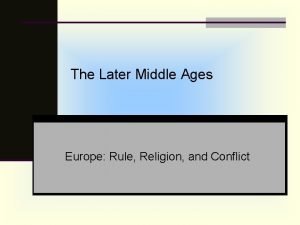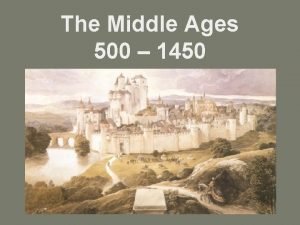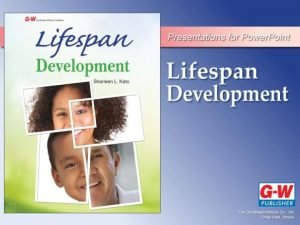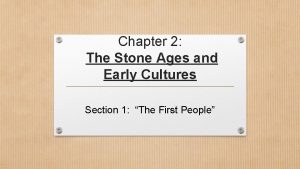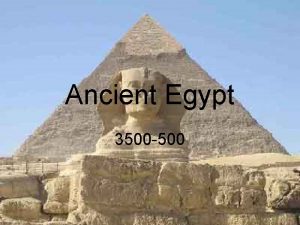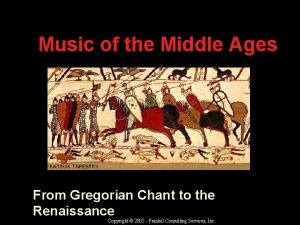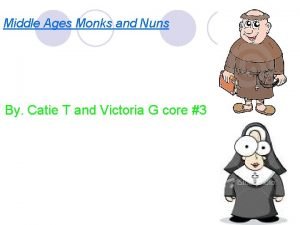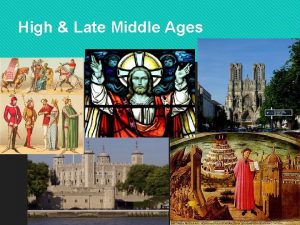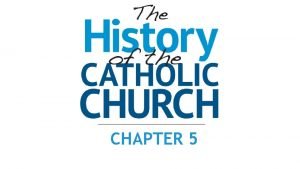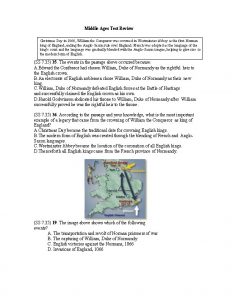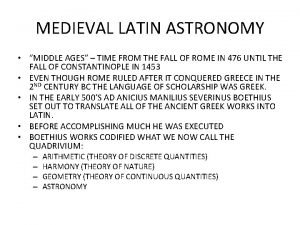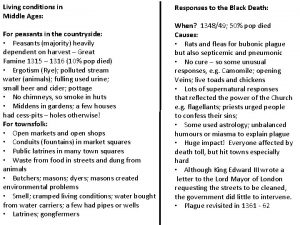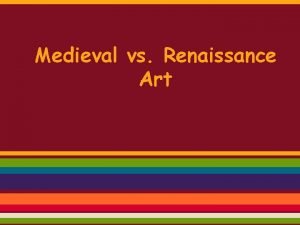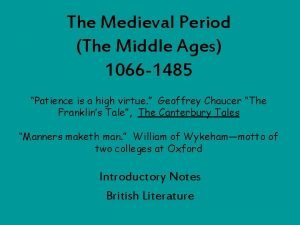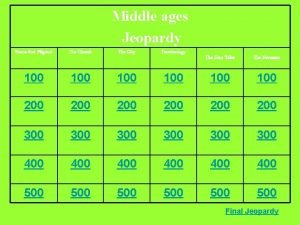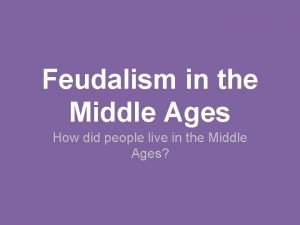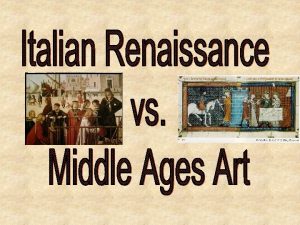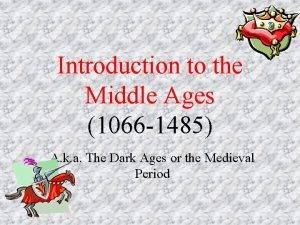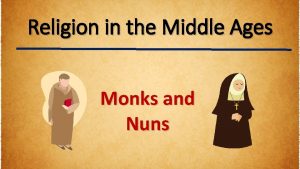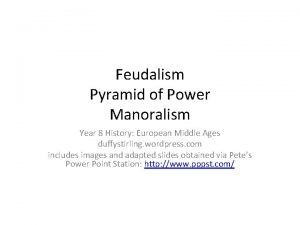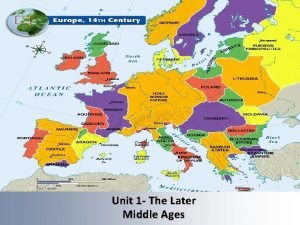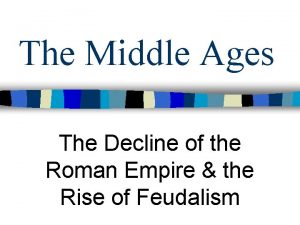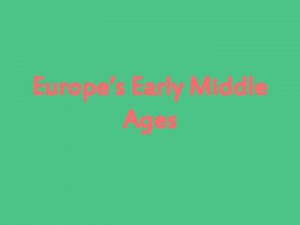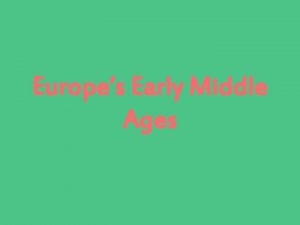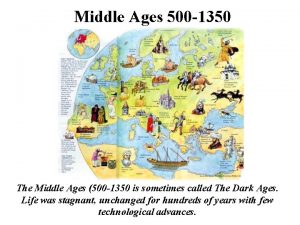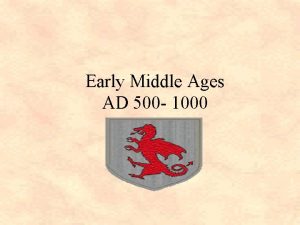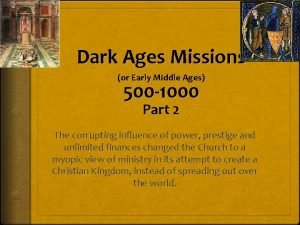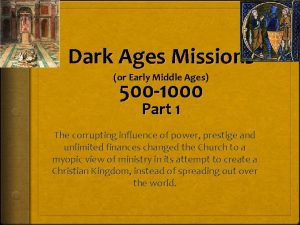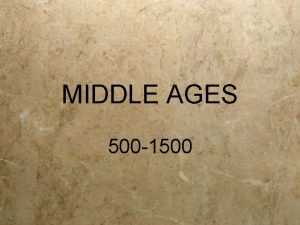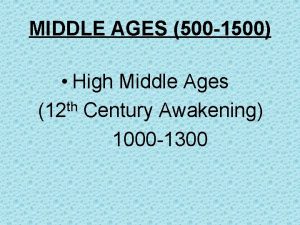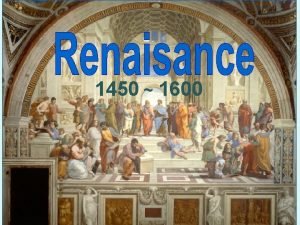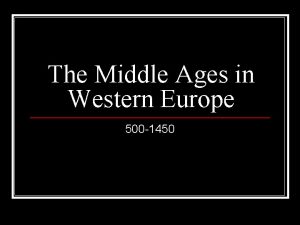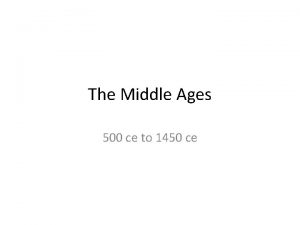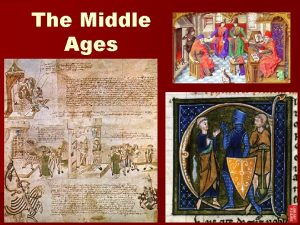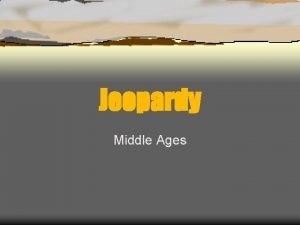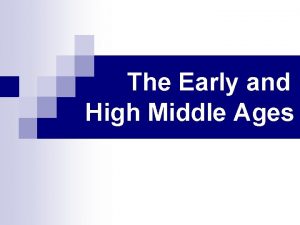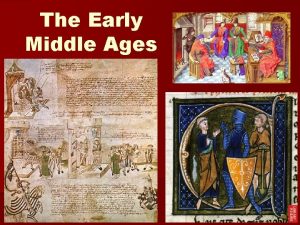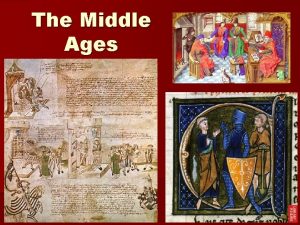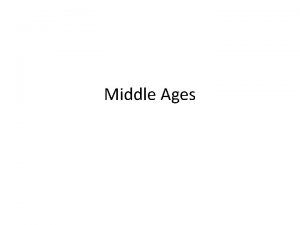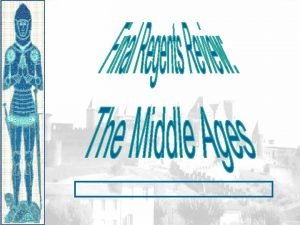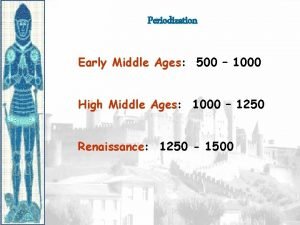The Middle Ages 500 1450 The Early Middle






























- Slides: 30

The Middle Ages 500 – 1450

The Early Middle Ages I. Geography – Europe! - Frontier Land – sparsely populated, undeveloped land on the outskirts of civilization (rich and untapped resources). II. Germanic Kingdoms - Between 400 and 700, Germanic tribes carved up Western Europe into small kingdoms. - Franks – conquest in Gaul and converted to Christianity. - Islamic power in the east was seen as a threat to Christian Germanic leaders.

The Geography of Europe

III. Charlemagne (Charles the Great) - Pope Leo III asked him to end rebellion – Crowned afterwards and united most of old Roman Empire (eastern emperor outraged – split increased between east and west). - Spread Christianity throughout Europe (blending Roman, German, and Christian culture). - Appointed nobles to govern local lands – Missi Dominici – officials to keep nobles in check by talking to locals and administer justice.

III. Charlemagne (Charles the Great) Cont. - Learning –Alcuin of York– created a curriculum (Latin based focusing on rhetoric, logic, math, music, and astronomy). - In 813, Charlemagne dies. In 843, Grandson’s create the Treaty of Verdun (Empire into 3 regions). - His rule was a last attempt to keep the legacy of Rome alive in Europe. After the death of Charlemagne, the Middle Ages permanently sets in!

Feudalism and the Manor Economy I. Emergence of Feudalism (need for protection) – from the Vikings! - Feudalism – powerful lord divides up land gives it to lesser lords (vassals). The lesser lords, in turn, gave service and loyalty to the powerful lord – known as a feudal contract. - Land granted – fief (estate), along with peasants to work the land. - Very complex and conflicting system – multiple vassals and fiefdoms.

Feudal System

II. Nobles - Warfare for lords was a way of life – trained knights (mounted warriors) – decreased over time to tournaments. - Chivalry – knight’s code of conduct (loyal, brave, and honest). - Troubadours – wandering poets – love songs about perfection, beauty of women.

III. Peasants and Manor life - Manor (with castle) lord’s estate, surrounding lands, and serfs (peasants bound to the land). - Serfs – farmed lord’s land paid tributes and received several acres to farm themselves as well as protection. - Manors were selfsufficient – church, village with one room huts, water mill, and land – no need to leave and most never did.


The Medieval Church I. The Church and Medieval Life - The church was key the everyday lives of Europeans – administered sacraments (sacred rites of the churchled to salvation), performed rituals, and guided people on moral issues. - Village Church –social center, required Christians to tithe (tax of 10%). - Women – “daughters of eve” – sin easily and needed protection.

II. Monasticism - Monks lived in monasteries Benedictine rule – rules of regulate monastic life (obedience to abbot, poverty, chastity). They worshipped, studied, and worked to sustain the convent/monastery. - Performed basic services to the community, re-copied ancient works into Latin - kept learning alive in the middle ages.

III. Church Power Grows - Church becomes secular – involved in world affairs (Politics). - Papal Supremacy under the Pope – representative of Christ on earth (with extreme power) - Canon Law – laws for religious teachings, clergymen, marriages, and morals. - If you broke Canon Law, you could be excommunicated from the church (denied sacraments or Xn burial). - Reform Movements - Monks and clergy were violating vows – prohibited marriage of priests, and ended the selling of church offices (simony). - Friars – monks that would travel and preach to the poor. - Anti-Semitism – prejudice against Jews – became moneylenders or moved east.

Economic Expansionism and Change I. Agricultural Revolution and Trade - Use of iron plows (moldboard plow) with horse harness, windmills, three- field system (one for grain, two for legumes, and three rested). - New trade routes brought good from Middle East and goods were sold at trade fairs (food, drink, entertainment) – created first cities (controlled by merchants). - With these new innovations, feudal systems decline and merchant cities emerge!

4 Agricultural Revolution New farming technologies iron plow harness windmill three-field system Increase in food production Population explosion Between 1000 and 1300, the population of Europe doubled.

II. Commercial Revolution - Merchants needed Capital (money needed for investment) and partnerships (two or more working together to fund a large venture). - Bill of exchange – paper to represent coin in foreign land (traveler’s check). - Artisans, merchants, and traders became the first members of the middle class. - Guilds – merchants and artisans formed associations (like unions). Competitive and power oriented and based on a worker’s skill (bakers, carpenters, weavers guilds, etc. ) - To become a member, start as an apprentice (trainee) to journeymen (salaried workers) to guild masters.

Royal Power in England France I. Strong Monarchs in England - William of Normandy, France (descendant of the Vikings) claimed English throne – fought the Anglo-Saxons of England won crown at the Battle of Hastings. - Called William the Conqueror blended Norman French and Anglo-Saxon culture. - Created the Domesday Book (census of the kingdom) and collected more taxes. - New political traditions evolved, including common law, the jury system, and Parliament. - In 1215, King John signed the Magna Carta - nobles had certain rights, the king would not raise new taxes without first consulting the lords and clergy (kings must obey the laws).

II. Successful Monarchs in France - Capetians – built effective bureaucracy (tax collection, royal law enforcement). - Phillip IV and Pope Boniface VIII argue over who has more power and set up the Estates General – body of representatives of all three classes (clergy, nobles, and townspeople) – set up to be similar to British Parliament.

Europe looks Outward I. The Crusades - Crusades (Holy War) Byzantine empire asked for the help of Christian knights to push the Muslim Turks out of the Holy Land. - Thought it would heal the schism between the east and west churches. - Lasted 200 years – not very successful Jerusalem was taken by the Muslims. Also tried to take other Muslim lands and were defeated.

II. Effects of the Crusades - The Crusades sparked European interest in a wider world and resulted in a revival of exploration (Marco Polo – China) and trade. - Also reaffirmed the power of feudal monarchs and the papacy (church).

III. The Reconquista in Spain - During the Reconquista, Spain expelled the Muslims from their land created a unified state under King Ferdinand Queen Isabella. - Ended religious tolerance and wanted religious unity - launched a Spanish Inquisition and crusade against Jews and Muslims – victims burned at the stake and 150 k fled.

Learning, Literature, and the Arts I. Medieval Universities - Built around cathedrals to train clergy – evolved into academic centers. - Students listened to lecture, explanations of Latin texts, and would memorize them. - Seven Liberal Arts – arithmetic, geometry, astronomy, music, grammar, rhetoric, and logic. - Earned degrees such as Bachelor of Arts (3 -6 yrs) and Master of Arts (2 -4 more).

II. “New” Learning - Ancient Greek philosophy, math, and science lost after the fall of Rome – translated in the middle east by Muslims into Arabic, then by Jews into Latin. - Greek philosophy and logic challenged Christian ideas of faith – created Scholasticism – reason used to support Christian beliefs (ex: Thomas Aquinas). - Studied Hippocrates (medicine), Euclid (geometry), Aristotle (physical world), and adopted numbers instead of Roman numerals.

III. Medieval Literature - Vernacular – everyday languages of common people (French, Italian, German). - Wrote epics – long narrative poems (Song of Roland, Poem of the Cid, Dante’s Divine Comedy, and Canterbury Tales by Geoffrey Chaucer).

IV. Architecture and Art - Roman influences – fortress with thick walls created a dark and gloomy feel. - Used Flying Buttresses – stone support outside the church – higher walls and allows for stain glass windows – holy or heavenly feel. - Stone scene sculptures from the bible and stain glass – religious education. - Gothic style also appeared in artistic decoration in books (illumination). “Flying” Buttresses

Gothic Architecture!

Time of Crisis I. Black Death - Epidemic of bubonic plague – outbreak of rapid-spreading disease. - Spread through fleas on rats. – spread all over the world (7 k a day)! - 35% to 70% of the population died! - Workers died and production declined – inflation – pricing rose – created laws for limiting wages, hired less people, guild shrank – created social unrest.

The Symptoms Bulbous Septicemic Form: almost 100% mortality rate.

II. Hundred Years’ War (13371453) - English rulers wanted control over French land of their Norman ancestors. - English win at first – due to the longbow (3 x faster than crossbows and could cause more damage). - In 1429, Joan of Arc told the King of France that God sent her to save France – inspired French soldiers to fight and pushed back the British. - The English captured her, accused her of witchcraft, and burned her at the stake. - Effects: French nationalism, end of a Continental British Empire, and a need for large, armored armies due to the use of longbow and cannons.

Sum it up: The Middle Ages starts with the devastation of Rome and enters a time where all things revolve around survival. However, slowly through the Catholic Church’s power and influence, the Middle Ages will come out of its “trance” to re-unite with its Greco. Roman roots!
 Dark ages vs middle ages
Dark ages vs middle ages Renaissance vs medieval art
Renaissance vs medieval art Early middle ages
Early middle ages Early middle ages
Early middle ages 500/1450
500/1450 Chapter 7 early childhood ages 3 through 5
Chapter 7 early childhood ages 3 through 5 The stone ages and early cultures
The stone ages and early cultures 3500-500
3500-500 How is this
How is this Gregorian chant composers
Gregorian chant composers Catiet
Catiet Sacred music of the middle ages
Sacred music of the middle ages Late middle ages timeline
Late middle ages timeline High to late middle ages
High to late middle ages Similarities between middle ages and renaissance
Similarities between middle ages and renaissance Middle ages test review
Middle ages test review Astronomy in medieval times
Astronomy in medieval times Living conditions in the middle ages
Living conditions in the middle ages Medieval vs renaissance art
Medieval vs renaissance art Middle english period 1066-1500
Middle english period 1066-1500 American floral design history
American floral design history Language answer
Language answer Feudal system in the middle ages
Feudal system in the middle ages Renaissance vs middle ages
Renaissance vs middle ages Middle ages buildings
Middle ages buildings The middle ages 1066 to 1485 unit test closed book
The middle ages 1066 to 1485 unit test closed book Monks and nuns in the middle ages
Monks and nuns in the middle ages The feudalism pyramid
The feudalism pyramid Middle ages def
Middle ages def European middle ages map
European middle ages map Middle ages
Middle ages


